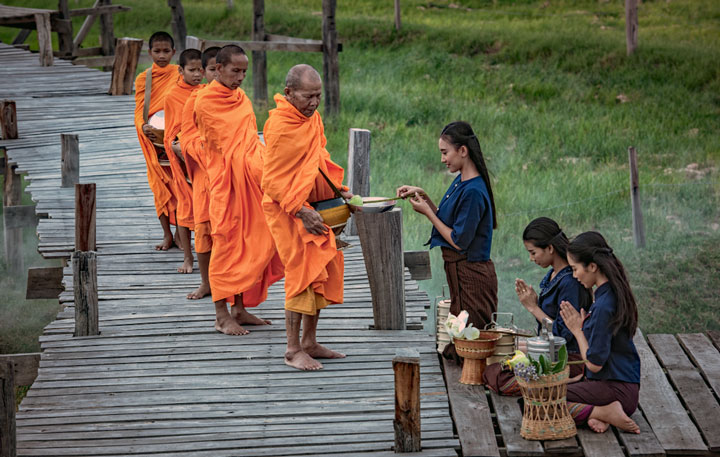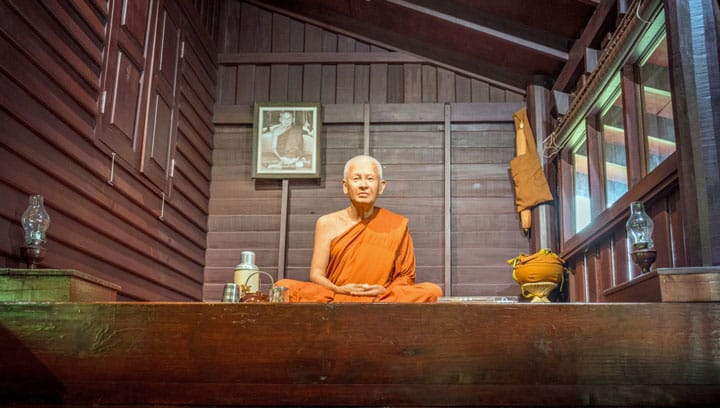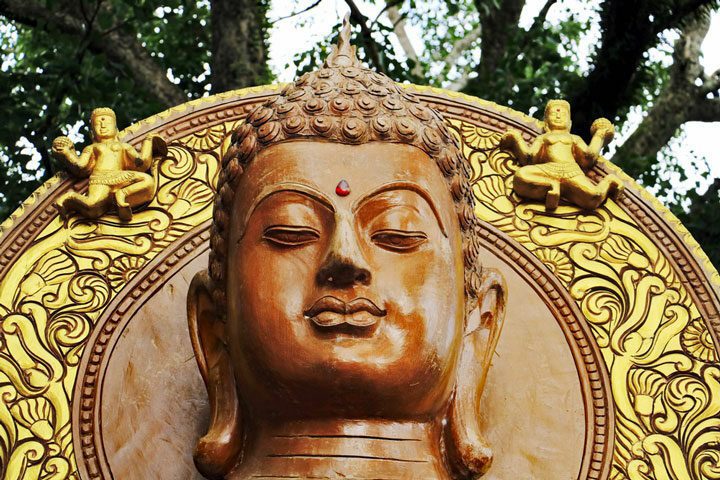The Western view of what Buddhism is and what Buddhist practices are inside and outside Asia can be very different from each other. Also in my articles, for example, I wrote an article about 'pure' Buddhism, stripped of all miracles, bizarre rituals and black pages. But I also once wrote a critical story about the position of women in Buddhism. In this piece I will explain some of those different views.
The different directions within Buddhism
All Buddhists derive their views from the life of the Buddha, but the way this is elaborated can vary greatly. There are roughly three main streams, which have a large number of further branches. Unfortunately, these further currents were not always gentle with each other.
Therevada
In Southeast Asia, including Thailand, the Theravada school (“the word of the elders”). This is the oldest branch of Buddhism and relies on the oldest Pali scriptures. In the 5e century AD, this current was spread from Sri Lanka. Like all Buddhist denominations, it adapted to the prevailing local beliefs where animistic and magical rituals played a major role and still do today. In Thailand, animistic ideas and magical acts are an established part of mainstream Buddhism.
Mahayana
De Mahayana school ('the great vehicle') originated around the beginning of the Christian era and focuses on the existence of the Bodhisattva: the already enlightened being who does not yet want to enter nirvana, but in the here and now out of compassion other people helps to achieve enlightenment. Nirvana is the highest state attainable by man, free from greed, aversion and confusion. The Mahayana movement mainly spread to other Asian countries such as Tibet, Nepal, China, Korea and Japan. In China, this form of Buddhism often used concepts and expressions from older Taoism, also written as Daoism. The most well-known and valued Buddhist belief in the West, the Zen Buddhism, belongs to this movement and originated around 500 AD. Christ in China and was mainly practiced in Japan.
Vajrayana
The third direction is the Vajrayana school ('the vehicle of the thunderbolt', compare that with the name of the current Thai king, Vajiralongkorn 'the lord of the lightning'). Here meditation techniques, rituals and recitations (mantras) play a greater role.

Sasin Tipchai / Shutterstock.com
The 'pure and true' Buddhism
The life course of the Buddha is full of miraculous events that are generally accepted as true, especially in the East. Siddhartha ('has accomplished his goal') Gotama (or Gautama, his clan name), the later Buddha, was born in what is today India, on the border with Nepal. As was customary at the time, his heavily pregnant mother, Maya, was on her way to her native village to give birth. During her journey, she gave birth to her son in the village of Lumbini: Siddhartha was born from her right hip. He was able to stand at once, took a number of steps in the four directions, pointed to the heavens and the earth and spoke the following words: "I was born for the enlightenment and benefit of all beings, and this is my last birth." His mother died a week after his birth and was reborn in heaven where her son, then already the Buddha, flew one day to teach her for three months. Incidentally, the Buddha later forbade his disciples to boast about their miracles.
Especially in the west, but also in more intellectual circles in the east, these wonderful stories are usually omitted. They would not belong to the 'true core' of Buddhism.
The Western view of Buddhism: peaceful, women-friendly and for equality?
The West sees Buddhism as an extremely peaceful religion or belief. Well, that's not quite true. There is quite a bit of violent symbolism in some Buddhist denominations. There were certainly wars between Buddhists in the past, for example to conquer relics of the Buddha. Recently in Sri Lanka there have been Buddhist groups expressing hatred and opposition to Muslims and Christians. In Myanmar, the monk Ashin Wirathu was active, followed by many others. He preached hatred against Muslims and demanded their departure. He said, 'People should worship the Tatmadaw (military) MPs as if they were worshiping the Buddha'. Not all people in Myanmar agree with him, but a large number do. He also compared the well-known politician and activist Aung San Suu Kyi to 'a prostitute who sucks up foreign interests'.
Buddhism is actually a misogynistic movement. For example, a 21-year-old, inexperienced and newly ordained male monk is always higher in status than an older, wise and long-initiated female monk. For other examples see my article:

(Prosperous Photo / Shutterstock.com)
Meditation…..
The enlightenment of the Buddha is mainly attributed in the East to the good karma that he has accumulated in all his hundreds of past lives. Through good deeds with good intentions such as gifts, you can improve your karma and be reborn as a happier person. It does not have much influence on your current existence, so rebirth is an essential part of Buddhism here.
Karma, on the other hand, plays a minor role in the Western view which usually only refers to the Buddha's meditation under the Bodhi tree as the core of Buddhism and the state of enlightenment. In the East, especially among lay people, medication is not a very important Buddhist practice.
This Western vision arose in particular in the XNUMXs and XNUMXs when many Western young people traveled to the East to gain a deeper understanding of human existence and mental peace. Their Asian teachers quickly noticed that stories of miraculous events and magical powers didn't really impress them and that good reincarnation wasn't a priority either, and that's usually the case with all kinds of meditation.
For Westerners, meditation and other training such as mindfulness are therefore an important part of Buddhism, perhaps even the most important element. It improves your current life and helps with mental problems such as burnout and depression. There is nothing wrong with that, it reduces people's suffering and should be applauded. But to identify it with Buddhism is going too far for me.
Buddhism is an extremely multifaceted movement, philosophy, belief, religion, or whatever you want to call it, with many good sides and some bad practices.
I am very curious what the readers think about this.
Sources:
Paul van der Velde, In the skin of the Buddha, Balans Publishers 2021, ISBN 978 94 638 214 7 . (A highly recommended book by Paul van der Velde. He is professor of Hinduism and Buddhism at the Radboud University in Nijmegen).
Barend Jan Terwiel, Monks and Magic, NIAS Press, 2012, ISBN 978 87 7694 065 2
An interview with Paul van der Velde in response to the aforementioned book. Very useful to listen to!
#532: Buddhism in Eastern and Western Perspective. A conversation with Paul van der Velde – YouTube



A small correction to your interesting article. You write that “Buddha was born in what is today India, on the border with Nepal” in the village of Lumbini. Now I can confirm to you that Lumbini is 100% in Nepal, I have been there myself.
After reading it I wondered in which countries Vajrayana Buddhism is practiced (this is mentioned in the other two schools). These turn out to be mainly Tibet, Nepal and Bhutan.
Buddhism without reincarnation is going to be quite difficult. You do not reach the state of enlightenment in a single lifetime and even if you were, you will reach a state in which you will not be born again, but if that does not happen anyway… Then there is little left to do but abstinence and some of those things. Whether you can still put the label Buddhism on it?
Can laugh about the fact that when the hippies moved to the east, people thought "learning that white nose theory is not going to work, then just meditate". Imagine if people from Asia had moved to the US in the 20th century and ended up in those gospel churches there, if they didn't want to burden those poor Asians with too much theory and would especially enjoy singing and dancing together... Very sanoek of course, and maybe in Asia we had bible = song and dance, conviviality! can see. Hey.
Those stories of the Buddha's past life and related stories are a bit part of it in my opinion if you want to be able to place Buddhism better. For example, about rebirth, the Buddha said, quote: “He who would be a man again and again, birth after birth, must avoid the wives of others, as one who has washed his feet avoids the filth. She who wants to be a man, again and again birth after birth, should honor her husband as the servants honor Indra.”. (see the Narada jataka).
However, some of the jataka stories go very far in my view… Thus, the conclusion of the Asatamanta jataka is that, and I quote (!): “The Buddha told this story to his pupil to remind him that women are mean and only bring misery.” Or take the Takka jataka, I quote again: "The Buddha told him this story to remind his pupil that women were ungrateful, unreliable, dishonest, angry and quarrelsome and that religion was the only way to happiness."
And there are a few more: “women are evil by nature” (Radha jataka), and in several other stories, women try to divert the Buddha or a follower from the path of enlightenment with their temptations, which only bring harm to the man. to take. Quote: When the Bodhisattva heard why the student was absent, he explained to him that this was the nature of all women: like highways, rivers, courtyards and taverns, women make themselves public property. Therefore, wise men do not allow themselves to be humbled or upset if their wives commit adultery. After listening to the Bodhisattva's advice, the student stopped caring about what women do. (Anabhirati jataka).
Or as Tino once said before: if you are a good woman you can become a man in the next life according to the doctrine (that is "better"), and a bad man can go down and return as a woman. So anyone who wants to become a woman must misbehave himself… I don't think so. It's not a nice thought if you ask me!